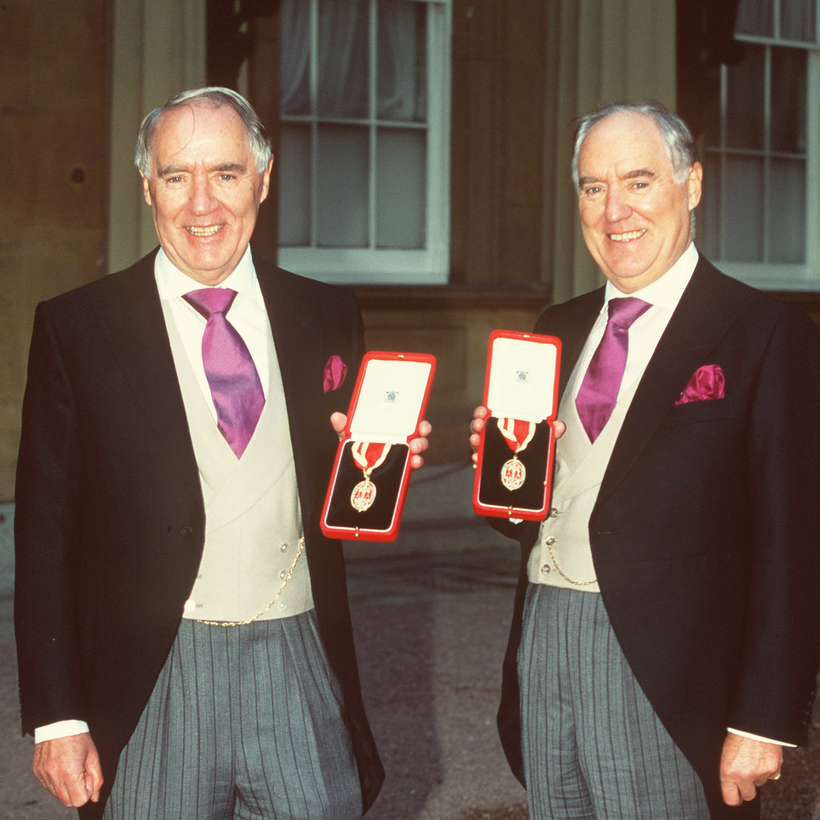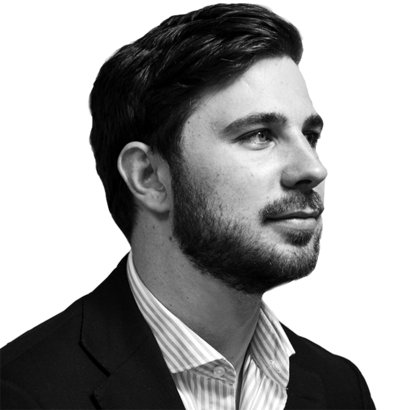The most you can say about the Barclay brothers is that there’s not a lot you can say about the Barclay brothers. Or not much that you can get past your fact-checkers and lawyers, anyway. Secretive, reclusive, litigious, the eccentric identical-twin tycoons—who own the Telegraph newspaper, the conservative weekly magazine The Spectator, and the Ritz hotel in London, among other British institutions—have long been surrounded by a potent and shadowy omertà. There’s the fortress-like home on the private island of Brecqhou, which the pair bought in 1993 (according to local legend, the narrow sound that divides it from nearby Sark has only once been successfully crossed at high tide); the twins’ alleged abstention from text and e-mail; the fact that there exists just a single picture of them together on Getty Images, taken in the year 2000 on the occasion of their knighthood; and the ardor with which they pursue those that offend them in print. The Barclays are not shy of publicity—they are mortally allergic to it. Theirs is an oil painting with the eyes redacted.
It is a delicious irony, then, that the billionaire twins, now aged 85, have been splashed all over the press this past month thanks to a case of high-stakes eavesdropping and rank indiscretion. The saga wends from the alleged bugging of the conservatory at the Ritz, deep into the Barclays’ complex web of business interests and assets. But it is also the story of a family in the throes of a Lear-grade crisis, with a level of intergenerational suspicion that makes Succession look like Modern Family.
Born 10 minutes apart on October 27, 1934, to a Scottish traveling salesman and his wife, Frederick and David Barclay were raised in a small West London house, which they shared not just with their eight siblings but also with several other families. (“One of them nicked my tortoise,” childhood neighbor Shirley Hedges told The Times of London of the twins.) After their father died, in 1947, the brothers set up a painting-and-decorating business following a short stint as accountants at General Electric. Next, the pair became estate agents, then property developers, and then hotel barons. By 1970, the Barclays owned the vast Londonderry House hotel, on Park Lane, the lavishly appointed Cadogan hotel, on Sloane Street, and two more grand hotels that bordered Hyde Park. When they were knighted 30 years later, for their prodigious philanthropy, Sir David said their story was “a great example of what can be achieved in this country from whatever background or education or humble beginnings.”
It is the story of a family in the throes of a Lear-grade crisis, with a level of intergenerational suspicion that makes Succession look like Modern Family.
At the start of the 80s, the Barclays received a generous loan from Allied Arab Bank, helmed by Mohammed Mahdi Al Tajir, who claimed at the time to be the richest man in the world. They used it to snap up a series of trophy assets, starting with The European and The Scotsman newspapers in the early 90s. (Jim Seaton, The Scotsman’s then editor, remembered the first time he met his new owners: “You may never see us again,” one of them said.) Then came the Mirabeau hotel in Monte Carlo, and then the Ritz in London, bought in 1995 for $94 million. The story goes that as a young man David took his mother to the hotel for high tea and told her, “One day, I’ll own this place.”
But it was the Telegraph Media Group, purchased in 2004 for $832 million, that became the twins’ most controversial acquisition. Bill Deedes, a former editor of The Daily Telegraph, called the Barclays’ incoming leadership a “stinking mob.” Others murmured that the editorial sanctity of the newsroom had been sullied by commercial interests. Journalist Peter Oborne quit the newspaper noisily in 2015 after an article was allegedly pulled from the Telegraph Web site about a tax scandal at HSBC, an advertiser. “What they have done is vandalism on an epic scale,” Oborne said last year. “It’s vulture capitalism—buying an asset and then milking it for cash.” Between 1924 and 2004 just six men had edited the paper. In the 16 years since the Barclays bought it there have been six more.

Then there’s the castle—the perfect physical manifestation of the brothers’ gaudy secrecy. Clad in gleaming granite and perched above the craggy bays of the island, Fort Brecqhou is a 92-room pseudo-Gothic mishmash complete with stone ramparts, market gardens, rolling vineyards, and working cannons. The banquet hall is more than 80 yards long, with a gold-leaf ceiling, while the upstairs quarters consist of plush, broad parlors in red and gold brocade. Waiters wear white monogrammed blazers and serve drinks in glasses emblazoned with ‘D’ and ‘F’ filigrees. (“All this nonsense about trying to be discreet,” says one Mayfair businessman. “Really, they love the mystique that’s been created.”)
The twins re-landscaped the entire island to create pockets of tranquility sheltered from the North Atlantic winds. Tourists are now allowed to visit the grounds, subject to prior arrangement and security clearance—but there is a strict prohibition on any photos of the castle itself. Sir David and Sir Frederick rarely venture onto nearby Guernsey unless in disguise, reportedly due to their long-held fear of kidnapping. The inscription above the front door reads: Aut agere aut mori, Latin for “Do or die.”
Then there’s the castle—the perfect physical manifestation of the brothers’ gaudy secrecy.
As of 2004, 10 members of the Barclay clan were said to be living in the castle. It is the seat of their sprawling operations, and is, crucially, situated within a tax haven. The family tends to stick together, too. When one of the twins’ daughters was denied inheritance rights due to an ancient tradition of Sark (the larger, neighboring island, which effectively holds jurisdiction over Brecqhou), the brothers took the local administrators to the European Court of Human Rights and won. But now, as the patriarchs look to unravel the knotted web of the family firm, the knives have been drawn. Down at Fort Brecqhou, the barbarians are not at the gate—they are in the drawing room.
Last month, the High Court of Justice in London heard claims that Sir Frederick Barclay had for several months been spied on by his nephew Alistair, who used “an elaborate system of covert recording.” Allegedly in cahoots with his brothers Aidan and Howard, Alistair—the 30-year-old, race-car-driving son of Sir David by his current wife—is said to have bugged the conservatory at the Ritz. This was apparently Sir Frederick’s favorite spot for an afternoon cigar, and he would sit there for hours at a time with his daughter, Amanda, to discuss matters both personal and professional—not least the future of the brothers’ empire, which was reportedly put up for sale in October. (The Ritz has attracted at least a dozen interested buyers, including Bernard Arnault of LVMH.)
The smoking gun was a video of Alistair “handling the bug placed in the conservatory” on January 13. Desmond Browne, Q.C., representing Sir Frederick and Amanda Barclay, said the evidence showed “illegal activity over a long period of time.” (Sir David is not a party to the case, which has been filed against his sons Aidan, Alistair, and Howard; Aidan’s son Andrew; and Philip Peters, who holds a board position in the Barclay group of businesses. Nor is David’s son Duncan, who is less involved with the family business).
This sort of accusation is not unusual in the Barclays’ dealings. Paddy McKillen, a rival property developer who owns the London hotels the Connaught and Claridge’s, became entangled in a lengthy legal dispute with the brothers. He described them as an “immoral,” “dishonourable,” “highly aggressive” pair of “philistines” to The Guardian in 2014. But this is the first time, seemingly, that members of the family have used such dirty tactics against one another. “You’d be surprised at how commonplace this kind of thing is among families, sadly,” one adviser to wealthy sovereign households told me. “Most people operating at this level tend to sweep every meeting room for bugs. But how the hell do you sweep the Ritz?”
Sir Frederick’s side of the clan has long felt vulnerable to a land grab. His only daughter, Amanda, who has a minority 25 percent share of the family trust, according to the Financial Times, is not a director of the Bermuda-based holding company that oversees the core Barclay assets. A week after the bug was sniffed out, Amanda was reportedly fired from the boards of six Ritz subsidiary companies and replaced by her cousins.
And then, last week, in a highly uncharacteristic public statement, Sir Frederick hinted that more legal action could yet arise—specifically if the Ritz was sold for less than the $1.24 billion he deems it to be worth. He went on to say, “I am deeply shocked and saddened about recent events involving unethical conduct and intrusion into my privacy. I hope we can get these family matters resolved so that we can all move on.”
“Most people operating at this level tend to sweep every meeting room for bugs. But how the hell do you sweep the Ritz?”
It seems unlikely that the rift will be mended soon. Once upon a time the twins were said to be “mirrors” of each other—yin and yang in charcoal suits; the Krays with knighthoods. “One has a parting on the right, the other on the left,” a friend told The Times of London in 2004. “David is basically optimistic whereas Freddie is fairly pessimistic. They act as a clever duo because they take opposite points of view all the time.”
“They used to eat together, sleep together, hold hands. They had different ties but the same jackets. In the summer months they lived on the yacht Lady Beatrice,” another source recently told the same newspaper. “They’ve now got a yacht each. They’re all at war. The old boys aren’t talking.”
Down in Mortlake Cemetery, West London, just a few miles from the Barclays’ childhood home, the great divide has been set in stone. A few years ago, a new headstone was installed on the twins’ father’s grave, in black granite with gold lettering. It displays the names of Sir David Barclay and an older brother, Andrew—but Sir Frederick Barclay’s name is nowhere to be seen. Family members have told the Financial Times that they are “deeply hurt” by the unexpected slight.
“Our business is large,” Sir Frederick said in a rare witness statement in 2012. “But it is a family business.” This small fact may prove to be the empire’s ultimate undoing.
Joseph Bullmore is a Contributing Editor for Air Mail


